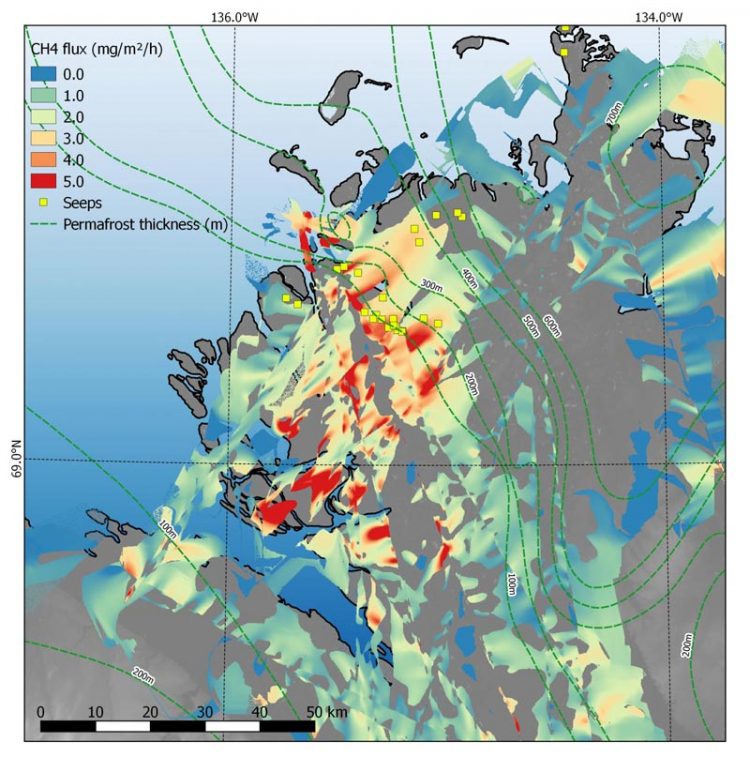Thawing permafrost releases old greenhouse gas

Map of the methane fluxes in the northern part of the study area. Picture: B. Juhls, GFZ
The thawing permafrost soils in the Arctic regions might contribute to the greenhouse effect in two respects: On the one hand rising temperatures lead to higher microbial methane production close to the surface. On the other hand thawing subsurface opens increasingly pathways for old, geologic methane.
This is shown in a study in the Mackenzie Delta (Canada), conducted by scientists from the German Research Centre for Geosciences GFZ, the Alfred Wegener Institute, Helmholtz Centre for Polar and Marine Research (AWI) and partners in the US. The study is published in the journal Scientific Reports.
Arctic permafrost acts like a gigantic cap of frozen material over mineral resources and fossil fuels. Scientists apprehend that thawing permafrost could lead to rising methane emissions. “We wanted to find out how much methane is released in a region and were looking for spatial patterns in gas emissions”, says lead author Katrin Kohnert from GFZ´s section for Remote Sensing.
In order to do so a team led by GFZ scientist Torsten Sachs performed a study in a 10,000 square kilometers wide area in Northern Canada. By the help of the research aircraft Polar 5 of AWI the scientists conducted airborne measurements of gas concentrations in the air during two extensive flight campaigns in summer 2012 and 2013, respectively.
The result was a high-resolution (100 m x 100 m) methane flux map of the Mackenzie Delta. “We found strong emissions solely where the permafrost is discontinuous, meaning parts where the permafrost contains areas that are thawed permanently”, says Katrin Kohnert.
“We think that the methane comes predominantly from deeper geologic sources and not from recent microbial activity close to the surface.” Even though the hotspots only occur on about 1 percent of the area, they contribute 17 percent to the annual methane emission estimate of the study area.
The conclusion of the authors: The warming climate triggers not only the natural production of biogenic methane, it can also lead to stronger emissions of fossil gas. This contributes significantly to the permafrost-carbon-climate feedback. Kohnert: “Therefore permafrost areas vulnerable to thawing warrant much more attention.”
Media Contact
All latest news from the category: Earth Sciences
Earth Sciences (also referred to as Geosciences), which deals with basic issues surrounding our planet, plays a vital role in the area of energy and raw materials supply.
Earth Sciences comprises subjects such as geology, geography, geological informatics, paleontology, mineralogy, petrography, crystallography, geophysics, geodesy, glaciology, cartography, photogrammetry, meteorology and seismology, early-warning systems, earthquake research and polar research.
Newest articles

High-energy-density aqueous battery based on halogen multi-electron transfer
Traditional non-aqueous lithium-ion batteries have a high energy density, but their safety is compromised due to the flammable organic electrolytes they utilize. Aqueous batteries use water as the solvent for…

First-ever combined heart pump and pig kidney transplant
…gives new hope to patient with terminal illness. Surgeons at NYU Langone Health performed the first-ever combined mechanical heart pump and gene-edited pig kidney transplant surgery in a 54-year-old woman…

Biophysics: Testing how well biomarkers work
LMU researchers have developed a method to determine how reliably target proteins can be labeled using super-resolution fluorescence microscopy. Modern microscopy techniques make it possible to examine the inner workings…





















